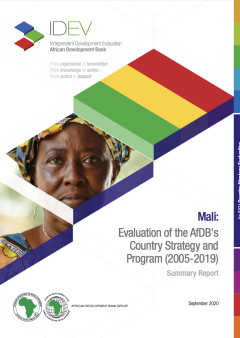
Mali Country Strategy and Program Evaluation for the period 2005-2019
The objectives of the evaluation were to:
- Fulfill the Bank's accountability mandate to stakeholders by presenting the results achieved ;
- Enable the Bank and its stakeholders in Mali to improve the design and implementation of future development operations in the country following the lessons and recommendations from the evaluation; and
- Strengthen the evaluation capacities of development actors in Mali.
The evaluation found that the performance of the Bank’s intervention strategies and programs in Mali was satisfactory in terms of relevance, sustainability, efficiency and consideration of cross-cutting aspects (such as gender, environment and youth), but unsatisfactory in terms of effectiveness, impact, institutional performance, and addressing fragility by building resilience.
Main lessons:
- In the configuration of Bank assistance, it is possible to maintain selectivity while showing the necessary flexibility to a country’s changing needs;
- The Bank can achieve substantial and tangible outcomes, even in difficult contexts, by developing strategies and operations in a participatory manner with the government and civil society; developing projects in synergy with other technical and financial partners; establishing clear results frameworks on the basis of which results can be monitored and measured; adopting more flexible approaches in situations of fragility; and responding quickly to emergencies; and
- Effective collaboration between the Bank and other development partners is essential in Mali, among others to build the capacity of the private sector and civil society in addition to that of the State.
The evaluation’s three main recommendations are (i) to increase the Bank’s impact on the country’s development, through a greater private sector share in the operations portfolio and a larger Bank contribution to knowledge; (ii) to enhance engagement by the Country Office with different categories of development partners in Mali, including developing and implementing a communication and civil society involvement plan; and (iii) to improve the Bank’s performance in the implementation of operations.
